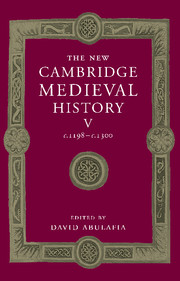Book contents
- Frontmatter
- Introduction
- Part I Common Themes
- Part II The Church in the Thirteenth Century
- Part III The Western Kingdoms
- Part IV Italy
- 15 Northern Italy
- (a) Northern Italy: The maritime republics
- (b) Sardinia and Corsica from the mid-twelfth to the early fourteenth century
- (c) The rise of the signori
- (d) Florence
- 16 The kingdom of Sicily under the Hohenstaufen and Angevins
- Part V The Mediterranean Frontiers
- Part VI The Northern and Eastern Frontiers
- Appendix Genealogical tables
- Primary sources and secondary works arranged by chapter
- Index
- Plate section
- Map 1 Europe in the thirteenth century
- Map 3 France, c. 1260
- Map 5 Germany and the western empire
- Map 6 Genoa, Venice and the Mediterranean
- Map 8 The Latin empire of Constantinople and its neighbours
- Map 10 Aragon and Anjouin the Mediterranean">
- References
(b) - Sardinia and Corsica from the mid-twelfth to the early fourteenth century
from 15 - Northern Italy
Published online by Cambridge University Press: 28 March 2008
- Frontmatter
- Introduction
- Part I Common Themes
- Part II The Church in the Thirteenth Century
- Part III The Western Kingdoms
- Part IV Italy
- 15 Northern Italy
- (a) Northern Italy: The maritime republics
- (b) Sardinia and Corsica from the mid-twelfth to the early fourteenth century
- (c) The rise of the signori
- (d) Florence
- 16 The kingdom of Sicily under the Hohenstaufen and Angevins
- Part V The Mediterranean Frontiers
- Part VI The Northern and Eastern Frontiers
- Appendix Genealogical tables
- Primary sources and secondary works arranged by chapter
- Index
- Plate section
- Map 1 Europe in the thirteenth century
- Map 3 France, c. 1260
- Map 5 Germany and the western empire
- Map 6 Genoa, Venice and the Mediterranean
- Map 8 The Latin empire of Constantinople and its neighbours
- Map 10 Aragon and Anjouin the Mediterranean">
- References
Summary
INTERNAL STRIFE AND EXTERNAL PRESSURES
AROUND the middle of the twelfth century Sardinia was still divided, politically, into four small kingdoms, also known as judgeships (from the title of iudike held by their rulers). This system dated back to the ninth and tenth centuries, and to the breaking of the bonds between Sardinia and the eastern empire. There was the judgeship of Gallura in the north-east, of Cagliari in the south, of Arborea in the west, and of Torres or Logudoro in north-central Sardinia. All these statelets were characterised by several common features: the absence of feudal bonds; chronic underpopulation; the servile condition of the majority of the population (a servitude linked not to the soil but to labour obligations); the survival of a public judicial system; a well-ordered administrative division into curatorie, within which were the ville, with at their head the curatori as representatives of the judges. But all were subject from the mid-eleventh century to a variety of powerful external pressures consequent upon the ending of the isolation which had characterised the island in the early Middle Ages.
In the religious sphere the papacy, as is clear from the intervention of Pope Gregory VII, was anxious to bring the island into line with the institutions and customs of western Christianity, challenging the strong local tradition of Greek Orthodoxy and creating more than nine new dioceses, as well as favouring the influx of Benedictine monks from Montecassino, Vallombrosa, Camaldoli and St Victor’s, Marseilles. They contributed significantly to the Latinisation of the Sardinian Church, including the introduction of writing styles from the mainland and the spread of Romanesque architecture, and they also initiated agricultural improvement schemes. They were sometimes supported, sometimes challenged, by Pisa and Genoa as they all began to penetrate politically, culturally and economically into the island.
- Type
- Chapter
- Information
- The New Cambridge Medieval History , pp. 447 - 457Publisher: Cambridge University PressPrint publication year: 1999

